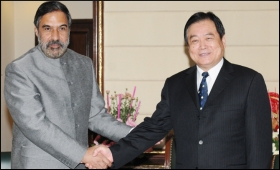
In 2004, a rash of early scientific reports suggested that cell-phones, which produce radio frequency energy, might cause a fatal form of brain cancer called ‘glioma,' reminisces Siddhartha Mukherjee in The Emperor of all Maladies: A biography of cancer (www.harpercollins.co.in). “Gliomas appeared on the same side of the brain that the phone was predominantly held, further tightening the link. An avalanche of panic ensued in the media…”
Recall bias
The Pulitzer-winning book goes on to inform that an enormous British study was launched in 2004 to confirm these ominous early reports; and ‘cases' (patients with gliomas) were compared to ‘controls' (men and women with no gliomas), in terms of cell-phone usage.
The study, reported in 2006, appeared initially to confirm an increased risk of right-sided brain cancers in men and women who held their phones on their right ear, the author notes. He adds, however, that when researchers evaluated the data meticulously, a puzzling pattern emerged — that right-sided cell-phone use reduced the risk of left-sided brain cancer. The simplest logical explanation for this phenomenon, as Mukherjee mentions, was ‘recall bias,' that is, patients diagnosed with tumours unconsciously exaggerated the use of cell-phones on the same side of their head, and selectively forgot the use on the other side.
When the researchers corrected for this bias, there was no detectable association between gliomas and cell-phone use overall, reads an apparently reassuring message in the book. “Prevention experts, and phone-addicted teenagers, may have rejoiced — but only briefly. By the time the study was completed, new phones had entered the market and swapped out old phones — making even the negative results questionable.”
New carcinogens
In the author's view, the cell-phone case is a sobering reminder of the methodological rigour needed to evaluate new carcinogens. While it is easy to fan anxiety about cancer, he reminds that identifying a true preventable carcinogen, estimating the magnitude of risk at reasonable doses and at reasonable exposures, and reducing exposure through scientific and legislative intervention is far more complex.
The landscape of carcinogens is not static, instructs Mukherjee. “We are chemical apes: having discovered the capacity to extract, purify, and react molecules to produce new and wondrous molecules, we have begun to spin a new chemical universe around ourselves.” As a result, he observes that our bodies, our cells, our genes are being immersed and reimmersed in a changing flux of molecules, in the form of pesticides, pharmaceutical drugs, plastics, cosmetics, estrogens, food products, hormones, and even radiation and magnetism.
“Some of these, inevitably, will be carcinogenic. We cannot wish this world away; our task, then, is to sift through it vigilantly to discriminate bona fide carcinogens from innocent and useful bystanders,” advises Mukherjee, therefore.
A book that you may find yourself grabbing like a crab.
Reliability in a cloud
The introductory chapter of Google Apps Deciphered: Compute in the cloud to streamline your desktop by Scott Granneman (www.pearsoned.co.in) opens not with Google but with Microsoft Office, describing it as the undisputed 800-pound gorilla in the office suite jungle, with millions of users and billions of dollars in sales. “However, as we saw in King Kong, even the mightiest gorilla can be hurt by enough buzzing planes. If one of those planes is actually a mighty jet named Google, then good ol' Kong may be facing more trouble than he's anticipated,” adds Granneman.
Stating that every person who starts using Google Apps is potentially one less customer for Microsoft, he foresees a long-term loss of market share for the latter. “Microsoft has finally woken up to the fact that software and services are inexorably moving to the Net, and it has responded with its own attempts in this area, called Microsoft Online Services.”
Yet, in Microsoft's involvement, what the author sees is the continued practice of the ‘software plus services' model, where online tools still require the use of software running on a PC to work. “This protects Microsoft's cash cows, Windows and Office, first and foremost, while allowing the company to trumpet its participation in moving online as well.”
Network is the computer
A section on ‘cloud' traces how the idea — spoken of decades ago by Sun co-founder John Gage when he proclaimed that ‘the network is the computer' — has finally reached a period of reality and even hyper-growth thanks to the spread of reliable high-speed Internet access coupled with the virtually limitless supplies of computer storage and processing power. As it gets cheaper and cheaper for companies such as Google and Amazon to build out massive server farms and then connect those mind-bogglingly powerful resources to users across the world via the Net, new and exciting technologies become possible, the author notes.
Taking up the question of reliability, which is often posed by users in the context of cloud, Granneman concedes that even the mighty Google has stumbled, as in July 2008, for example, when Google Docs was unavailable to many users for an hour or so. His defence, though, is that virtually all companies have suffered downtimes, ranging from eBay to Amazon to Royal Bank of Canada to AT&T. “This is simply a fact of life. Downtimes will happen. Humans can attempt to plan for every eventuality, but mistakes, errors, and even natural events beyond our control intrude and cause problems.”
Illusion of control
An interesting psychological fact highlighted in the book is the ‘illusion of control' commonly exhibited by humans. “For instance, we are far more likely to die in a car than on a plane, but people are often psychologically more comfortable driving in their cars than riding on planes due to the fact that drivers feel in control of the situation, while passengers may not.”
Likewise, many people feel safer running their own servers instead of outsourcing to Google because they want that feeling of control over their machines and their data, the author observes.
“However, Google now offers a service level agreement (SLA) for the Premier Edition of Google Apps that guarantees 99.9 per cent uptime for Gmail (that means about 9 hours of downtime a year)…”
Recall bias
The Pulitzer-winning book goes on to inform that an enormous British study was launched in 2004 to confirm these ominous early reports; and ‘cases' (patients with gliomas) were compared to ‘controls' (men and women with no gliomas), in terms of cell-phone usage.
The study, reported in 2006, appeared initially to confirm an increased risk of right-sided brain cancers in men and women who held their phones on their right ear, the author notes. He adds, however, that when researchers evaluated the data meticulously, a puzzling pattern emerged — that right-sided cell-phone use reduced the risk of left-sided brain cancer. The simplest logical explanation for this phenomenon, as Mukherjee mentions, was ‘recall bias,' that is, patients diagnosed with tumours unconsciously exaggerated the use of cell-phones on the same side of their head, and selectively forgot the use on the other side.
When the researchers corrected for this bias, there was no detectable association between gliomas and cell-phone use overall, reads an apparently reassuring message in the book. “Prevention experts, and phone-addicted teenagers, may have rejoiced — but only briefly. By the time the study was completed, new phones had entered the market and swapped out old phones — making even the negative results questionable.”
New carcinogens
In the author's view, the cell-phone case is a sobering reminder of the methodological rigour needed to evaluate new carcinogens. While it is easy to fan anxiety about cancer, he reminds that identifying a true preventable carcinogen, estimating the magnitude of risk at reasonable doses and at reasonable exposures, and reducing exposure through scientific and legislative intervention is far more complex.
The landscape of carcinogens is not static, instructs Mukherjee. “We are chemical apes: having discovered the capacity to extract, purify, and react molecules to produce new and wondrous molecules, we have begun to spin a new chemical universe around ourselves.” As a result, he observes that our bodies, our cells, our genes are being immersed and reimmersed in a changing flux of molecules, in the form of pesticides, pharmaceutical drugs, plastics, cosmetics, estrogens, food products, hormones, and even radiation and magnetism.
“Some of these, inevitably, will be carcinogenic. We cannot wish this world away; our task, then, is to sift through it vigilantly to discriminate bona fide carcinogens from innocent and useful bystanders,” advises Mukherjee, therefore.
A book that you may find yourself grabbing like a crab.
Reliability in a cloud
The introductory chapter of Google Apps Deciphered: Compute in the cloud to streamline your desktop by Scott Granneman (www.pearsoned.co.in) opens not with Google but with Microsoft Office, describing it as the undisputed 800-pound gorilla in the office suite jungle, with millions of users and billions of dollars in sales. “However, as we saw in King Kong, even the mightiest gorilla can be hurt by enough buzzing planes. If one of those planes is actually a mighty jet named Google, then good ol' Kong may be facing more trouble than he's anticipated,” adds Granneman.
Stating that every person who starts using Google Apps is potentially one less customer for Microsoft, he foresees a long-term loss of market share for the latter. “Microsoft has finally woken up to the fact that software and services are inexorably moving to the Net, and it has responded with its own attempts in this area, called Microsoft Online Services.”
Yet, in Microsoft's involvement, what the author sees is the continued practice of the ‘software plus services' model, where online tools still require the use of software running on a PC to work. “This protects Microsoft's cash cows, Windows and Office, first and foremost, while allowing the company to trumpet its participation in moving online as well.”
Network is the computer
A section on ‘cloud' traces how the idea — spoken of decades ago by Sun co-founder John Gage when he proclaimed that ‘the network is the computer' — has finally reached a period of reality and even hyper-growth thanks to the spread of reliable high-speed Internet access coupled with the virtually limitless supplies of computer storage and processing power. As it gets cheaper and cheaper for companies such as Google and Amazon to build out massive server farms and then connect those mind-bogglingly powerful resources to users across the world via the Net, new and exciting technologies become possible, the author notes.
Taking up the question of reliability, which is often posed by users in the context of cloud, Granneman concedes that even the mighty Google has stumbled, as in July 2008, for example, when Google Docs was unavailable to many users for an hour or so. His defence, though, is that virtually all companies have suffered downtimes, ranging from eBay to Amazon to Royal Bank of Canada to AT&T. “This is simply a fact of life. Downtimes will happen. Humans can attempt to plan for every eventuality, but mistakes, errors, and even natural events beyond our control intrude and cause problems.”
Illusion of control
An interesting psychological fact highlighted in the book is the ‘illusion of control' commonly exhibited by humans. “For instance, we are far more likely to die in a car than on a plane, but people are often psychologically more comfortable driving in their cars than riding on planes due to the fact that drivers feel in control of the situation, while passengers may not.”
Likewise, many people feel safer running their own servers instead of outsourcing to Google because they want that feeling of control over their machines and their data, the author observes.
“However, Google now offers a service level agreement (SLA) for the Premier Edition of Google Apps that guarantees 99.9 per cent uptime for Gmail (that means about 9 hours of downtime a year)…”
 Incident 2day
Incident 2day




















